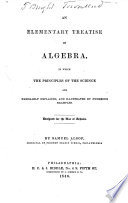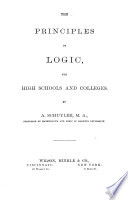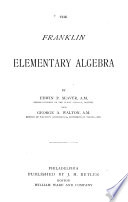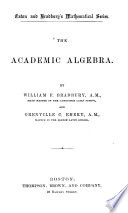 | Samuel Alsop - Algebra - 1846 - 300 pages
...arithmetical progression, and d the common difference. Then the series will evidently be if increasing a, a + d, a + 2 d, a + 3 d, a + 4 d, . . . if decreasing a, a — d, a — 2 d, a — 3d, a — 4 d. . . . By the inspection of the above... | |
 | Thomas Sherwin - Algebra - 1855 - 318 pages
...the first term, and d the common difference; then, if the progression be increasing, Id 3d 3d 4th 5th a, (a -|- d), (a + 2 d), (a + 3 d), (a + 4 d), &c., will be successive terms at the commencement of the series; or, if the progresUt 'it 3d 4th 5th... | |
 | Aaron Schuyler - Logic - 1859 - 180 pages
...difference of any increasing arithmetical progression, then from the law of the series, the terms will be, a, a + d, a + 2 d, a + 3 d, a + 4 d, . . . The coefficient of d in the second term being one, is one less than the number of the term, and... | |
 | Aaron Schuyler - Logic - 1869 - 180 pages
...difference of any increasing arithmetical progression, then from the law of the series, the terms will be, a, a + d, a + 2 d, a + 3 d, a + 4 d, . . . The coefficient of d in the second term being one, is one less than the number of the term, and... | |
 | Edwin Pliny Seaver, George Augustus Walton - Algebra - 1882 - 308 pages
...S = the sum of all the terms. With this notation an arithmetical progression is thus represented : a, a + d, a + 2 d, a + 3 d, a + 4 d . . . 363. To find an expression for the uth, or last, term. In the series above given, the coefficient... | |
 | William Frothingham Bradbury, Grenville C. Emery - Algebra - 1889 - 428 pages
...Term. In this Case, a, d, and n are given, and I is required. The successive terms of the series are a, a + d, a + 2 d, a + 3 d, a + 4 d, . . . that is, the coefficient of d in each term is one less than the number of that term, counting... | |
 | Claribel Gerrish, Webster Wells - Algebra - 1902 - 176 pages
...5(2), 3 + 6(2). Let a represent 3, d represent 2, I represent 15. Then the series could be written a, a + d, a + 2 d, a + 3 d, a + 4 d, a + 5d, a + 6 d. TEST R 1. From which term is the common difference absent? 2. How many times the cd... | |
 | John William Hopkins, Patrick Healy Underwood - Arithmetic - 1903 - 578 pages
...147 + 144 + ••• . SUM OF AN AP 390. Since A l = A» A 2 = A l + d, A n =A l +(nT)d. I. S n = A, + (A, + d) + ( A, + 2 d) + ( A, + 3 d) + (A, + 4 d) Writing the sums beginning with the last term, we have, II. S a = A n +(A n -d) + (A n -2d) + (A n... | |
 | Frederick Howland Somerville - Algebra - 1908 - 428 pages
...the common difference is —3. 401. In general, if a is the first term, and d the common difference, a, a + d, a + 2 d, a + 3 d, a + 4 d, . . . etc., is the general form of an arithmetical progression. 402. The nth Term of an Arithmetical... | |
 | Herbert Edwin Hawkes, William Arthur Luby, Frank Charles Touton - Algebra - 1911 - 288 pages
...denotes the first term and d the common difference, any arithmetical progression is represented by a, a + d, a + 2 d, a + 3 d, a + 4 d, etc. Here one observes that the coefficient of d in each term is one less than the number of the term.... | |
| |